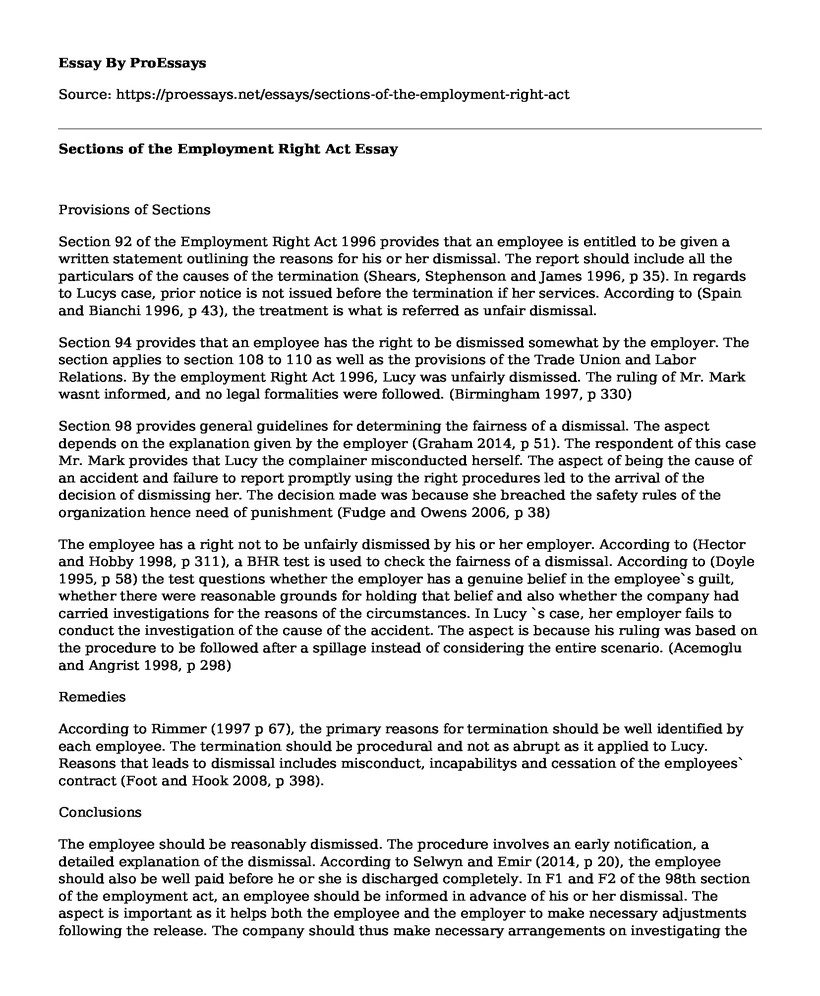Provisions of Sections
Section 92 of the Employment Right Act 1996 provides that an employee is entitled to be given a written statement outlining the reasons for his or her dismissal. The report should include all the particulars of the causes of the termination (Shears, Stephenson and James 1996, p 35). In regards to Lucys case, prior notice is not issued before the termination if her services. According to (Spain and Bianchi 1996, p 43), the treatment is what is referred as unfair dismissal.
Section 94 provides that an employee has the right to be dismissed somewhat by the employer. The section applies to section 108 to 110 as well as the provisions of the Trade Union and Labor Relations. By the employment Right Act 1996, Lucy was unfairly dismissed. The ruling of Mr. Mark wasnt informed, and no legal formalities were followed. (Birmingham 1997, p 330)
Section 98 provides general guidelines for determining the fairness of a dismissal. The aspect depends on the explanation given by the employer (Graham 2014, p 51). The respondent of this case Mr. Mark provides that Lucy the complainer misconducted herself. The aspect of being the cause of an accident and failure to report promptly using the right procedures led to the arrival of the decision of dismissing her. The decision made was because she breached the safety rules of the organization hence need of punishment (Fudge and Owens 2006, p 38)
The employee has a right not to be unfairly dismissed by his or her employer. According to (Hector and Hobby 1998, p 311), a BHR test is used to check the fairness of a dismissal. According to (Doyle 1995, p 58) the test questions whether the employer has a genuine belief in the employee`s guilt, whether there were reasonable grounds for holding that belief and also whether the company had carried investigations for the reasons of the circumstances. In Lucy `s case, her employer fails to conduct the investigation of the cause of the accident. The aspect is because his ruling was based on the procedure to be followed after a spillage instead of considering the entire scenario. (Acemoglu and Angrist 1998, p 298)
Remedies
According to Rimmer (1997 p 67), the primary reasons for termination should be well identified by each employee. The termination should be procedural and not as abrupt as it applied to Lucy. Reasons that leads to dismissal includes misconduct, incapabilitys and cessation of the employees` contract (Foot and Hook 2008, p 398).
Conclusions
The employee should be reasonably dismissed. The procedure involves an early notification, a detailed explanation of the dismissal. According to Selwyn and Emir (2014, p 20), the employee should also be well paid before he or she is discharged completely. In F1 and F2 of the 98th section of the employment act, an employee should be informed in advance of his or her dismissal. The aspect is important as it helps both the employee and the employer to make necessary adjustments following the release. The company should thus make necessary arrangements on investigating the primary cause of the problem rather than concentrating on the ruling. Lucy deserved a fair dismissal following her recent efforts as well as achievements. Mark could have first considered the cause of the spillage before passing the judgment of dismissing her. The aspect shows that the company owes Lucy an e detailed explanation of her dismissal failure to which she should be absorbed back.
References
Acemoglu, D. and Angrist, J., 1998. Consequences of employment protection? The case of the Americans with Disabilities Act (No. w6670). National bureau of economic research.
Birmingham, A., 1997. A guide to the Workplace Relations Act 1996. Australian Bulletin of Labour, 23(1), p.33.
Doyle, B.J., 1995. Disability, discrimination, and equal opportunities: a comparative study of the employment rights of disabled persons. Burns & Oates.
Foot, M. and Hook, C., 2008. Introducing human resource management. Pearson Education.
Fudge, J. and Owens, R. eds., 2006. Precarious work, women, and the new economy: The challenge to legal norms. Bloomsbury Publishing.
Grabham, E., 2014. employment equality law, 19962005. Knowledge, Technology and Law, p.51.
Hector, J. and Hobby, M., 1998. Labour market adjustment under the Employment Contracts Act: 1996. New Zealand Journal of Employment Relations, 22(3/1), p.311.
Reith, P., 1999. Delivering on work and family: the workplace relations act 1996. Australian Bulletin of Labour, 25(3), p.221.
Rimmer, M., 1997. The Workplace Relations Act 1996: An Historical Perspective. Australian Bulletin of Labour, 23(1), p.69.
Selwyn, N.M. and Emir, A., 2014. Selwyn's law of employment. Oxford University Press, USA.
Shears, P., Stephenson, G. and James, P.S., 1996. James' introduction to English law. Oxford University Press, USA.
Spain, D. and Bianchi, S., 1996. Balancing act: Motherhood, marriage, and employment among American women. Russell Sage Foundation.
Cite this page
Sections of the Employment Right Act. (2021, Mar 26). Retrieved from https://proessays.net/essays/sections-of-the-employment-right-act
If you are the original author of this essay and no longer wish to have it published on the ProEssays website, please click below to request its removal:
- Types of Threats Posed to the United States - Case Study Example
- Skills Required in Accounting Questions and Answers
- Montgomery College Should Allow Gun On Campus - Controversial Essay
- Essay Sample on Ethical Code in Police Profession
- Essay Sample on Crime Scene Investigations
- Effective Business Communication: Connected Employees = Higher Performance
- Paper Example on Affordable Care Act: Benefits & Services Covered







